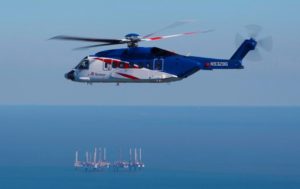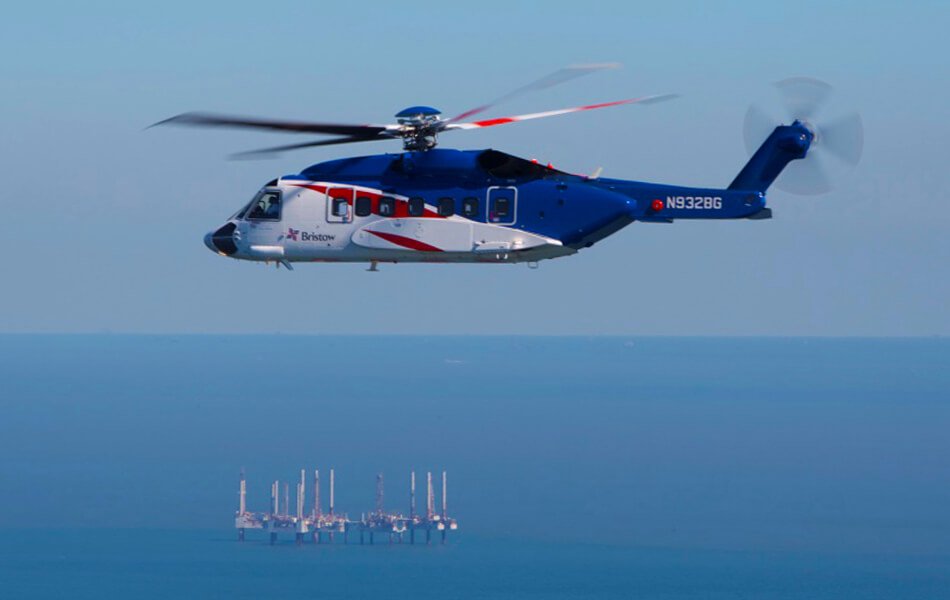The downturn in the offshore oil-and-gas industry has bottomed out and the sector is beginning its recovery, the major operators are reporting. Citing rotorcraft utilization numbers, they believe they are not of the woods yet, but do express optimism.

It has been one of the worst ever downturns in the oil-and-gas sector, caused by plummeting oil prices in 2014. The impact forced operators to implement restructuring plans — including job cuts — and manufacturers to ramp down production abruptly. Overcapacity is still keeping flight hour pricing at low levels.
But now operators and airframers agree that a favorable trend has appeared. “There are signs of recovery,” said Mark Abbey, CHC’s regional director for Europe, Middle East and Africa.
Jamie John, NHV’s base manager in Aberdeen, Scotland, agrees. “The market has not returned to where it was five years ago, but [it] has been steadily improving,” he told Vertical. “Compared to a year ago, a lot more exploration campaigns are taking place.”
This has recently translated into a 30- to 40-percent increase in NHV’s monthly flight hours, or an extra 100 hours per month. “A lot of new players are coming to Aberdeen, purchasing assets in the field sold by legacy players,” John added. NHV is operating 15 helicopters in the North Sea.
Over at Bristow, the offshore giant has seen an increase in annual flight hours for the first time in three years. In its 2018 fiscal year, which ended on March 31, 2018, it recorded 165,000 flight hours — a 13,000-hour improvement over fiscal year 2017. “We are in a gradual recovery,” said Bristow president and CEO Jonathan Baliff. “Now offshore oil-and-gas is becoming cost-competitive again and our clients realize they need to run a portfolio.”
A Sikorsky representative is similarly positive. “We have seen an increase in the percentage of flight hours for the S-92 helicopter fleet operating in the offshore oil-and-gas segment,” David Martin, Sikorsky’s VP for oil-and-gas and leasing, told Vertical. Also, the number of S-92s not flying is decreasing to the point of “nearing single digits,” he added.
“We have seen a nearly 10-percent increase in flight hours for the S-76D fleet in the first quarter of 2018, as compared to the first quarter of 2017,” said Martin, noting that the medium segment (to which the S-76 belongs) is where most of the offshore flying happens.
Airbus’s head of oil-and-gas market, Alexis Vidal, is somewhat more cautious. “While it is too early to talk about a recovery, we have seen a double-digit increase in spending for exploration and development in 2017 compared to 2016, and this has continued rising since January 2018,” he said.
Both Vidal and Martin emphasized the market remains “difficult.” There remains “a significant excess capacity” of offshore helicopters in the market today, Vidal pointed out. Martin agreed the market is still “oversupplied.”
“We are beginning to hear conversations about what the future holds,” CHC’s Abbey said, describing himself as “cautiously optimistic.”
He has hope in renewable energies as a growth relay. The construction of a wind farm needs a lot of helicopters. Then, multiple maintenance checks are required every year for a wind turbine.
“For helicopters, the sweet spot is when wind turbines are built 40 nautical miles from the shore,” Abbey said. CHC already has contracts in the wind industry.
Consulting service provider Westwood Global Energy Group sees “a significant opportunity” in the offshore wind market. Almost 6,000 turbines are to be installed globally between 2018 and 2022, bringing the global total to 10,000, according to Westwood. It expects $119 million of offshore wind-related helicopter expenditure over the forecast – a growth rate of 39 percent.
Back to oil-and-gas, Bristow’s Baliff said he expects the gradual recovery to continue over the next 12 months. Will all this translate into employee recruitment and aircraft orders? “We have started hiring pilots – we let one third of our workforce go since the downturn began,” Baliff said.
But airframers are not expecting a rebound in sales anytime soon. “While there are some encouraging signs, we anticipate flat demand for commercial helicopters in 2018,” said Sikorsky’s Martin.
Baliff estimates the industry does not need more helicopters. “Let’s sweat the assets, we want to use the existing fleet more because it is young,” he said.
The only short-term hope, for manufacturers, is new models replacing older ones. “We have seen a shift from the use of heavies to super-mediums,” said Airbus’s Vidal.









